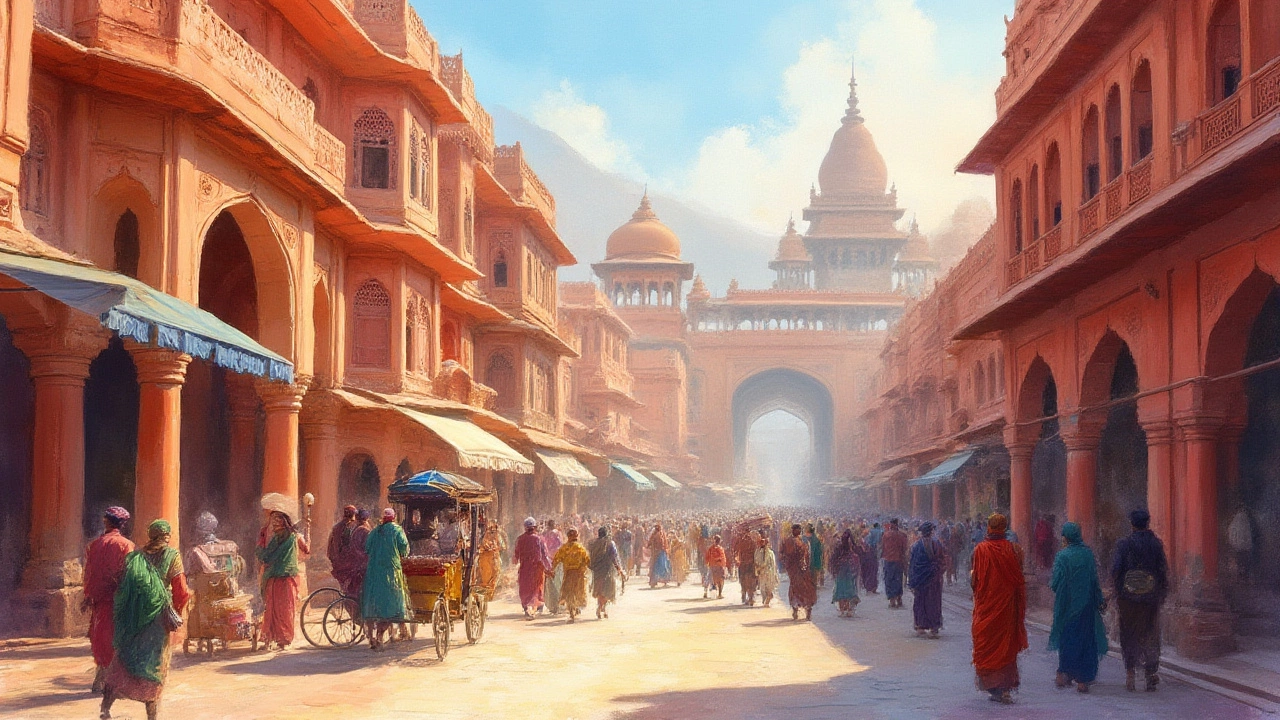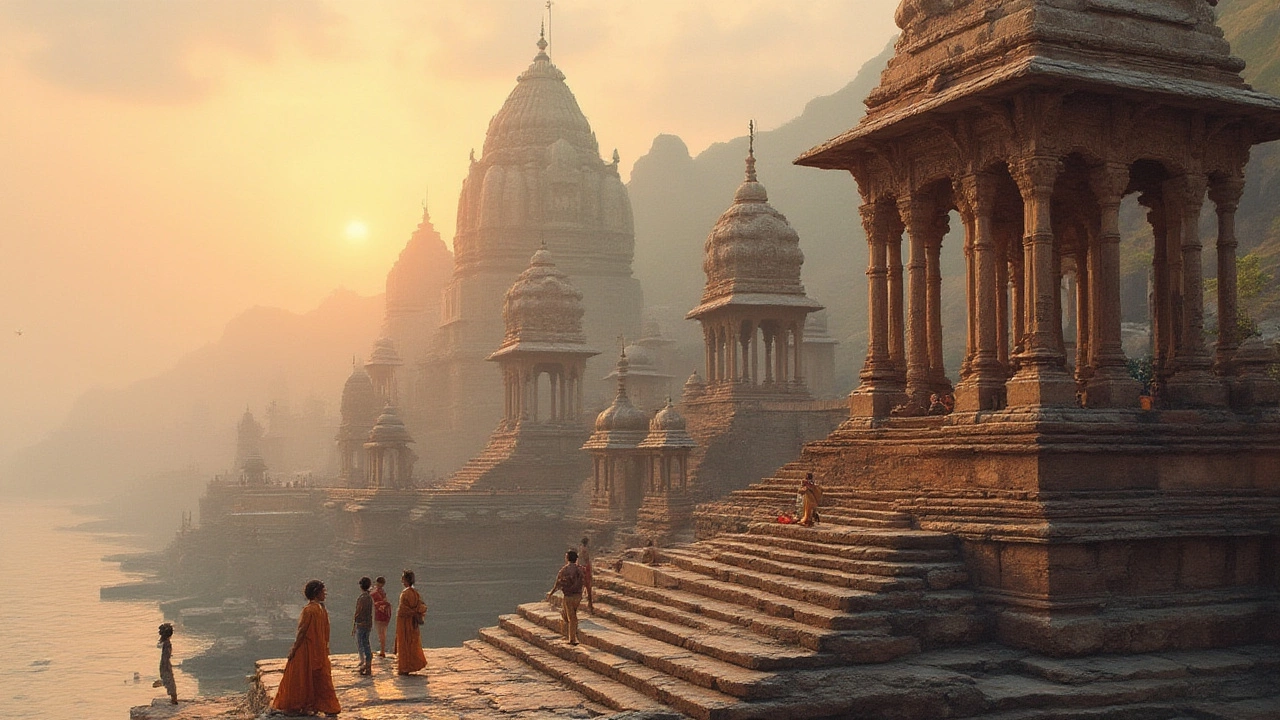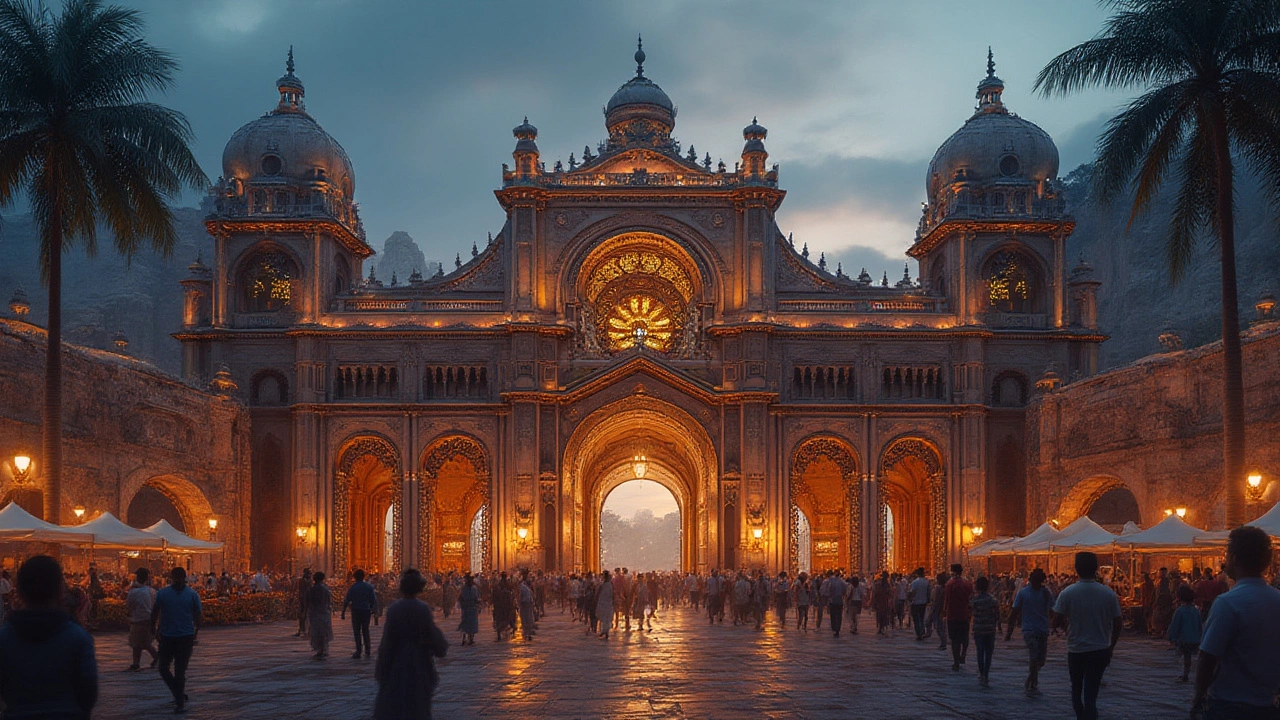Most Beautiful Architecture in India: Stunning Cities to Visit

- Jul, 8 2025
- 0 Comments
- Aaron Blackwood
Ever felt that rush when you spot a building that just takes your breath away? India is a magnet for moments like that. Here’s something few people realize—across its cities, the country holds a jaw-dropping mix of ancient forts, palaces, futuristic towers, and wild, colorful temples stacked lid to base. But ask anyone, “Which city has the most beautiful architecture in India?” and you’re jumped by a storm of opinions. Each city wants the crown. And honestly, for good reason. The architectural scene here isn’t just wide, it’s absolutely electric—steeped in history, tangled in culture, and punched up by wild creativity. For the curious, the traveler, the photo-collector, or anyone who just loves eye-candy buildings, there’s no easy winner. But hey, let’s dig deep and line up the big contenders.
What Makes Indian Architectural Cities Unique?
If you’ve ever stood in front of the Taj Mahal and felt its marble chill, you get what I’m saying—Indian architecture isn’t just about good looks. It’s part storybook, part mystery. Most cities in India don’t just parade their fancy facades. Every carved wall, every dome, every block of jharokha windows is a time capsule. Some cities bank on grandeur (hello, Jaipur and Udaipur), some flaunt modern chic (think Chandigarh), and others—even in chaos—pull off centuries-old elegance mixed with urban grit, like Kolkata.
What’s bananas is how styles mix and clash: You’ll find Mughal, Rajput, Gothic, Art Deco, Indo-Saracenic, Buddhist, Dravidian ... all in a single walk (no exaggeration). Take Mumbai—its famous Chhatrapati Shivaji Maharaj Terminus fuses Victorian Gothic and Indian craftsmanship, and the UNESCO recognizes it as a marvel. Or consider Hyderabad, where the Charminar and the sprawling Chowmahalla Palace seem to come straight out of royalty fiction, while techie Hitec City juts out with glass and steel. It’s like the cities are both stuck in a royal ball and a startup pitch fest.
Cities like Varanasi and Madurai haven’t cared to join the ‘modern city’ race—their beauty is in the wild, layered, lived-in temples and crowded ghats that have stood for centuries. Bengaluru, on the other hand, surprises with its elegant 19th-century Parliament building and IT parks fighting for skyline supremacy. You want offbeat? Look toward Ahmedabad, with pols (historic housing clusters) showing off the vibrancy of communal city life and local design. And Delhi, you ask? It’s basically a living storyboard from Sultanate days to glassy power corridors and British colonial leftovers. Delhi even pulls visitors through centuries as they move across Old Fort, Red Fort, Lotus Temple, and Rashtrapati Bhavan.
Let’s not forget the chilly charmers—Shimla’s British cottages, Dharamshala’s Tibetan compounds—each one stamped by climate and culture. Despite the range, cities in southern India—Mysore, Thanjavur, Kochi—pull you into mazes of palatial homes and massive temples, drawing architects, dreamers, and Instagrammers like moths to neon.
The point? The best architecture in India isn’t cookie-cutter. Some cities wear their beauty on shiny sleeves, others tuck theirs into noisy lanes. And what makes them unique? Mashups, stories, resilience, and that feeling you get when a city makes you want to stay out late just staring up. Want a tip? Visit with open eyes—and take the side streets whenever you can. That’s where the dreamers built.

The Strongest Contenders: Picking the ‘Most Beautiful’ City
So, straight up: people love to argue this. But a few names pop up every single time when it comes to architecture in India: Jaipur, Udaipur, Mumbai, Delhi, Hyderabad, Chennai, Ahmedabad, Kolkata, and sometimes Chandigarh.
Jaipur: This city will hijack your senses. Nicknamed ‘The Pink City’, Jaipur boasts everything from the staggeringly detailed Hawa Mahal (basically a latticework honeycomb in stone) to the pastel City Palace and the pyramid-like Amber Fort. You’re surrounded by Rajput design brilliance. Guided tours here often spotlight secret corridors, mirrored halls, and entire palace wings that look straight out of a fantasy movie. Here’s a fun tip: Climb up Nahargarh Fort for a full view of the layout. That honey-pink grid of buildings—seriously photogenic, especially at sunset.
Udaipur: Dubbed the 'Venice of the East,' Udaipur specializes in romance. The white marble City Palace sprawls across the lakeside, backed by grey-green hills, while Jag Mandir and Lake Palace float like royal party pads. The whole scene could humble an architect or a painter. Most buildings still use traditional lime plaster, creating that dreamy, almost sugary-white effect by the water. Insider hack: Stay at a heritage hotel and wake up to sunrise over Lake Pichola—you’ll never look at hotel chains the same way again.
Mumbai: Nowhere else in India will you see such a bold stack of styles. Mumbai’s British colonial influences (like the Gateway of India and Chhatrapati Shivaji Terminus), Art Deco gems on Marine Drive, ancient cave temples on Elephanta Island, and high-glass skyscrapers all punch together. Did you know Mumbai has the second-highest number of Art Deco buildings in the world, right after Miami? UNESCO called Marine Drive’s ensembled look a World Heritage Site—that’s how iconic these buildings are. Best way to get that vibe? Walk the ‘Queen’s Necklace’ (Marine Drive) in the evening and watch the sun melt down behind domes and towers.
Delhi: Living history, right here. Walk from the Red Fort’s imposing gates to Lutyens’ manicured avenues, then wade into medieval ruins within Lodhi Gardens or the Qutub Minar’s spiral shadow. The city is a mix of tough old-world brick, domes, colonial chandeliers, and contemporary glass. For ancient-meets-modern drama, walk through Connaught Place and compare those stately white colonnades with the nearby Mughal icons. Fun stat: Delhi claims more historical monuments than most capitals in the world—over 1700 listed heritage sites. That’s a walking museum, if there ever was one.
Chandigarh: For people obsessed with modern design, Chandigarh is peak. Dreamed up by Le Corbusier in the 1950s, the city runs on a grid, with buildings rooted in clean lines and minimal fuss. The Capitol Complex—yes, a UNESCO World Heritage Site—puts function and form together like a well-rehearsed band. Here, the Rock Garden (constructed from waste materials) feels just as futuristic and cool as the Prospective Plaza. Planning to visit? Rent a cycle and coast the city’s sidestreets—spot how even regular shops stick to the aesthetic playbook. Efficiency never looked so cool.
Ahmedabad: It’s not flashy, but Ahmedabad is sneaky good. Its pols (tight, winding housing clusters with stunning woodwork) show off time-tested design for hot climates, while stepwells like Adalaj dazzle with their science-meets-style complexity. Don't sleep on the city’s modern marvels, though: Louis Kahn’s Indian Institute of Management and Balkrishna Doshi’s bold designs have put Ahmedabad on the world map for architects. Find the tales behind city mosques, sultanate forts, and of course, the beautiful Sidi Saiyyed Mosque with its legendary stonecarved ‘Tree of Life’ lattice window.
Kolkata: The 'City of Joy' delivers stately colonial buildings, playful Indo-Saracenic architecture (Victoria Memorial anyone?), and a scattered set of art deco houses. Some streets feel like time froze at the height of British influence, others—Sinclair Mansion, Marble Palace—are bursting with Bengali personality. Film buffs wander here sourcing real-life sets, while design students love clashing colors and fretwork. Local fact: Over 900 mansions called ‘Bonedi Baris’ dot the city—each one with stories of zamindars, feasts, and wild parties.
Mind-blown yet? Each of these contenders brings something irreplaceable. Still, if you want a tighter cheat-sheet, here’s a simple table comparing key features:
| City | Main Architectural Style | Most Iconic Site | UNESCO Heritage? |
|---|---|---|---|
| Jaipur | Rajput, Mughal Fusion | Hawa Mahal | Yes (Entire city core taken as World Heritage) |
| Mumbai | Colonial, Art Deco, Modern | Chhatrapati Shivaji Terminus | Yes |
| Udaipur | Mewar Rajput, Mughal | City Palace | No |
| Chandigarh | Modernist, Brutalist | Capitol Complex | Yes |
| Delhi | Mughal, Colonial, Contemporary | Qutub Minar, Red Fort | Yes (multiple sites) |
| Ahmedabad | Indo-Islamic, Modern, Vernacular | Stepwells, Pols Cluster Indian Institute of Management |
Yes (Historic city) |
| Kolkata | Colonial, Indo-Saracenic | Victoria Memorial | No |
Still stumped? Pick your vibe: For royal palaces, go Udaipur or Jaipur. Art lovers? Try Mumbai or Kolkata. Futurists and design nerds—Chandigarh. Heritage walkers—Delhi or Ahmedabad. Or better yet, compare for yourself.

Smart Tips for Experiencing Indian Cities’ Architectural Wonders
You don’t need to be an architect to fall for these cities. But you’ll get a lot more out of your trip with a few pro tips. For one, pick your season—Indian summers can be brutal for walking tours. Jaipur and Udaipur feel magical right after the monsoon, with fresh air and that 'washed clean' look. Mumbai’s winter is gentle, perfect for beach-side Deco walks. Delhi’s late autumn puts you in perfect picnic weather for monument hopping.
Find a local guide. Sure, guidebooks are great, but hearing the stories behind a palace brawl or how a designer dreamed up a building is next-level. For heritage homes (looking at you, Kolkata and Ahmedabad), knock on the door. Many still let visitors tour their private ballrooms or underground cellars—just ask nicely. And in cities like Delhi, heritage walks led by architects or historians spill secrets you’d never find online.
Travel smart: Water, sunscreen, comfy shoes. Many sites ask you to remove shoes (temples, heritage homes), so slip-ons help. Carry local currency for museums or camera fees. Watch for live festivals—cities like Jaipur, Chennai, Kolkata put on wild, light-studded processions in old streets that light up every balcony and pillar.
Be picky about your photos. Early morning or sunset gives you that golden wash—temple shikharas gleam and marble glows. For exact lighting times, ask locals or use weather apps. Want crowd-free shots in iconic spots? Hit less-known angles: Try the back alley behind Hawa Mahal, or the quiet side of Udaipur’s City Palace. Late evenings often see most guests gone, so you’ll have ornate courtyards to yourself.
Try to stay in a ‘heritage’ hotel or homestay. Cities like Udaipur and Jaipur offer palace hotels that let you wake up amid painted ceilings and courtyards filled with birdsong. Even in Delhi or Mumbai, a handful of hotels are inside former royal homes or colonial clubs—it’s like time-travel without the cheesy costumes. Bonus: Guests sometimes get private tours of areas regular visitors can’t see.
Don’t skip the outskirts or ‘new’ neighborhoods. Mumbai’s Bandra throws up modern glass villas; Jaipur’s suburban homes are painted wild colors. Chandigarh’s suburbs hide quirky murals and public art that break the minimalist mold. A short rickshaw ride off the usual track can turn up markets, stepwells, or temples where you’ll be the only tourist.
Curious for numbers? India has more than 40 UNESCO Heritage Sites, and nearly half are in or around its major cities. Art Deco fans—Mumbai alone has over 200 registered Art Deco buildings. Jaipur’s walled city covers about 6.5 square kilometers, all designed on a perfect nine-part grid, a planning marvel for the 1700s!
If you love collecting moments, not just photos, try this: join a workshop. Many cities offer short courses on mural painting, wood carving, or Mughal miniature sketching, often held in heritage settings. Not only do you get hands-on, but you come away with a story plus a keepsake better than any snow globe.
Finally, keep scanning upwards! So much of Indian architectural magic happens where most tourists don’t look—intricate roofs, latticed windows, hidden gods perched atop columns, or whole stories sculpted into building tops. A good pair of binoculars sometimes beats a selfie stick.
If you’re counting votes, Jaipur might nudge out the rest right now—thanks to that UNESCO World Heritage stamp and its balance of palatial coolness, market chaos, and mind-boggling color. But the heart wants what it wants, and architecture’s never just numbers. India gives you wonder after wonder if you slow down, take the turn, and look up. No Instagram filter needed. Promise.